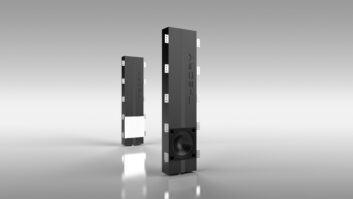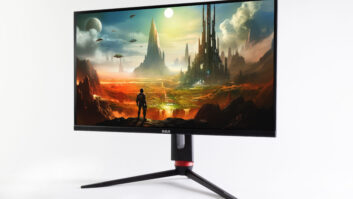NHT will follow up the launch of its eight Evolution speakers with sonically matching on-walls for rear and side channels, a restructured architectural series, and its first flat on-wall speakers.
The company is also developing its first speakers equipped with DSP to optimize driver performance, but they won’t likely ship until sometime in the first half of 2003, said VP/GM Chris Byrne.
In early April, NHT began shipping Evolution speakers, which consist of eight modular SKUs that can be combined to create up to 12 different surround-sound systems priced roughly from $3,000 to $6,500. They’re designed to offer flexible placement options, reduce a dealer’s SKU count and operate equally well for music and movie playback.
For flexible and unobtrusive placement, the bookshelf satellites and subwoofers are compact, and the satellites’ driver configuration makes them suitable for horizontal or vertical placement without altering their dispersion pattern. Also contributing to flexible placement: satellites and subwoofers with boundary-compensation controls to adjust response for in-cabinet placement and, for subwoofers, corner-placement.
To help reduce the SKU count, two powered-subwoofer modules can be docked with two satellites to create a biamplified tower speaker.
Byrne said the company achieved its Evolution sell-in goal by placing the products in 150 outlets representing about half the company’s dealer base. Most of the 150 outlets are operated by retailers who are aggressive in custom, he said.
Byrne admitted it took dealers awhile to understand the concept. “It’s not about good, better, best,” he said of Evolution. “It’s about two basic systems, and the difference is output and room size.” To understand the Evolution concept, dealers had to hear the speakers demonstrated in a custom or case-goods cabinet, and the satellites had to be demonstrated horizontally and vertically, he said.
To extend the Evolution lineup, NHT will go to CEDIA in September with a pair of Evolution on-walls in extruded-aluminum cabinets. Like other Evolution satellites, the three-way on-walls can be set up horizontally or vertically without changing dispersion. Including brackets, which can’t be seen from the side, they’re only 5.5-inches-deep. Response goes down to 70Hz. They might ship as early as November.
To tap into plasma TV success, NHT developed a pair of flat on-wall speakers and a matching on-wall powered subwoofer. “Some specialty dealers are selling seven to 10 plasma screens per month,” Byrne said. The passive satellites, which can also be mounted horizontally or vertically, are tuned for on-wall placement. A single tweeter is flanked by four 2-inch woofers on each side in a cabinet that’s 3.5 inches wide and less than 3 inches deep. The drivers plug into a crossover-equipped circuit board that runs the length of the enclosure. The satellites go down to 80Hz, at which point the 12-inch subwoofer takes over. The sub is 5-inches-deep, 28-inches-wide, and 18-inches tall.
The plasma-oriented speakers will be introduced either at CEDIA or January’s CES.
In architectural speakers, NHT plans a CEDIA introduction of three in-walls that could be the first in-walls that use a concentric driver design to deliver broad 120-degree dispersion and enhanced off-axis response, Byrne said. “In-walls are usually used for background, and really good coverage is needed,” he explained. By concentrically mounting a tweeter and two dome midranges over a woofer, NHT will deliver more flexible placement options without sonic “hot spots,” he said. Fewer speakers will be needed to provide good coverage, he added.
Concentric in-walls aren’t common, he noted, because “broad dispersion is easier to achieve in cabinet speakers.” That might explain why pivoting tweeters and pivoting tweeter/midrange combinations are used in some in-walls to allow for flexible placement, he said, but the drawback to those designs is that they “steer the hot spot.”
The three in-walls will be priced at $200, $300, and $450/pair. Each uses a baffle of the same size to make it easier for consumers to replace a lower priced model with a higher priced model at a later date.
Three of four planned in-ceiling speakers will continue to use NHT’s three-tweeter array to deliver 60-degree off-axis response, Byrne said. They’ll also be NHT’s first in-ceiling speakers with 70-volt capability for commercial-market compatibility, and they’ll be available through the company’s pro and home divisions. “The lines between custom and commercial are blurring,” he noted. Prices range from $200-$500/pair. Three use 6.5-inch woofers, and the top model uses an 8-inch woofer.
Shipments of planned DSP speakers have been pushed back from this year because of changing design plans, Byrne said. “The DSP is done, but we’re working on configuration issues in electronics,” he said. Because the system will dedicate one amplifier per driver, “we’re trying to use digital amps to keep the components small,” Byrne said. A component-width, 1.75-inch chassis will house the DSP and amplification for a single channel. A prototype might be demonstrated at CEDIA.
The targeted price is $3,500/channel, plus or minus $500. A five-channel home theater system will thus cost from $15,000-$20,000.
DSP will be used to implement crossovers, equalization, and driver time-alignment.













